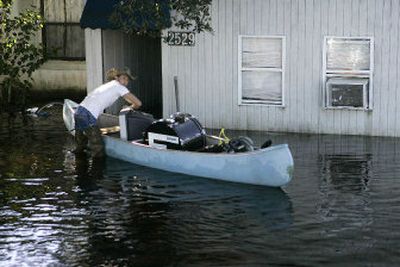Flood insurance can be a smart buy

No matter where you live, resolve in the new year to protect your home and property from nature’s fury by adding flood insurance to your homeowner’s coverage.
Why?
Without flood insurance, your home is at risk and unprotected by the most basic residential policies.
Coverage for flooding fills the gap in your homeowner’s insurance and safeguards your property against high water caused by heavy rainstorms, devastating hurricanes and runoff from melting snow.
Virtually anything from a stopped-up gutter to other water-related occurrences can be categorized as a flood and may not be covered by a home insurance policy.
Simply put, your residential policy covers damage from wind or rain – water that comes from above – and pays to repair structural damage and the cleanup of flood debris. But it doesn’t cover water that comes from below. Consult your insurance agent to find a policy that’s right for you.
Annual premiums range from $200 to $600 or more, depending on the severity of the flood risk, and provide up to $250,000 in building coverage and up to $100,000 for personal property. On average, the cost of a flood insurance policy for a home is about $400 a year for about $100,000 of coverage, according to data cited on the National Flood Insurance Program’s Web site. You can also buy separate coverage for the contents of your home.
If you aren’t convinced that flood insurance is something you need, then consider these facts: Your home has a one in four, or 25 percent, chance of sustaining flood damage during the course of a 30-year mortgage, compared with a 9 percent risk of being damaged by fire, according to the Federal Emergency Management Agency.
What’s more, nearly 25 percent of all claims paid by the National Flood Insurance Program in 2005 were doled out to policyholders in flood areas considered to be of “low to moderate risk.”
During the 12-month period between May 2005 and May 2006, many states have seen the number of homeowners buying flood insurance increase in record numbers, with policies in Mississippi outpacing the nation with a 41.4 percent jump, from 42,730 to 60,435, ahead of New Hampshire, up 26.2 percent, from 5,421 to 6,842, according to Foster’s Daily Democrat of Dover, N.H.
Louisiana, which saw a 9.6 percent increase, has the fourth-highest number of policy enrollees at 381,075, and Florida leads the country with 2.07 million policies in force, according to the Daily Democrat.
In the wake of Hurricane Katrina’s multibillion-dollar swath of destruction and severe flooding caused by other major storms in the Northeast along the Delaware River, flood insurance is top of mind today for many homeowners, who are often required by their mortgage lenders to obtain coverage for homes standing in flood-prone areas.
How do you know whether your home sits in a flood plain and may be at risk for high water? FEMA maintains a flood zone Web site where homeowners can view their home’s risk potential on flood zone maps. The maps indicate zones where flood insurance is required and impact insurance rates. The greater the risk, the greater the insurance premiums. Your insurance agent can quickly call up maps online, too.
FEMA rates flood zones for risk with an alphabetic system. Zones with the letter “A” are most susceptible to severe flooding, and if you live in an “A” flood zone, flood insurance will be a mortgage requirement. Zones “B”, “C”, “D”, “V” and “X” are lesser-risk areas, and the insurance may not be mandatory.
Areas designated at risk for flooding are based on the threat of a “100-year flood,” which is defined by FEMA as a flood that has a 1 percent chance of being equaled or exceeded in any given year.
Homeowners are wise to gauge their risk before making any decisions about investing in flood insurance. But having that insurance policy on hand may bring you peace of mind some day. Whether that once-in-a-lifetime storm arrives, or the neighborhood storm sewer backs up, your home and property will be protected.